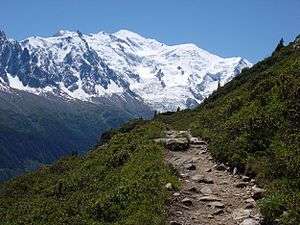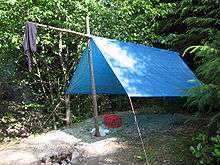Fastpacking
Fastpacking is a marriage of trail running and ultralight backpacking:[1][2] "it is hiking the ups, jogging the flats, and running the downs," depending on the gradient, because of the weight carried.[3] Participants carry a light pack with essential supplies, including a sleeping bag and tent, or similar form of shelter, if mountain huts or other accommodation is not available.[4][5] The weight carried will vary but fastpackers aim at no more than 15 pounds (6.8 kg) and some achieve less than 10 pounds (4.5 kg).[6] This activity may be undertaken either unsupported, self-supported, or supported. "Unsupported fastpackers make no use of outside assistance along the route", while self -supported fastpackers will leave caches of supplies along the intended route.[7]

Fastpacking involves covering a considerable distance over several days with a pack, which requires both mental and physical strength. Established, well-traveled long distance trail are used because "with minimal extra food and clothing, getting stuck in the backcountry for an extended period of time can quickly become a dangerous proposition".[8]
Routes
Fastpacking makes use of long distance trails including: in the United Kingdom the South Downs Way, Wainwright’s Coast to Coast Walk and the West Highland Way; in Europe the Tour du Mont Blanc, the "Alta Via 1" in the Dolomites, and the Alpine Pass Route;[9] in the USA the John Muir Trail in California and the Appalachian trail.[10] In New Zealand world-famous routes such as the Milford, Routeburn, and Abel Tasman Tracks that take hikers several days to walk can be covered by fit fastpackers in one or two days.[11]
Equipment
On a fast packing trip luxury items are left at home. In addition extra straps can be cut and things made to serve more than one purpose. For example clothes worn during the day are worn at night for extra warmth, which also means a lighter sleeping bag is needed.[12]
Backpack
Ultralight frameless packs are commercially available in weights ranging from eight to fourteen ounces (200–400 g)[13] and can consist of not much more than a sack with shoulder straps, a return to the simplicity of the rucksack. Some fastpackers make their own "ultralight pack".[14]
Footwear
Lightweight footwear is essential because it is estimated that "every pound on your feet equals 5 pounds (2.3 kg) on your back", so that reducing the weight of boots by 2 pounds (0.91 kg) rather is equivalent to "removing 10 pounds (4.5 kg) from your pack".[15] Most fastpackers wear running shoes.[16]
Shelter
A tarp provides the lightest type of shelter as it can weigh 1 pound (0.45 kg) or less, and can be strung from a tree, or propped with branches.[17]
Ten essentials
The Ten essentials that are recommended to all hikers.[18]
- Map in waterproof container and compass
- Sun protection: Sunglasses, sunscreen, etc.
- Insulation: Jacket, hat, rain shell (and when necessary gloves and thermal underwear).
- Headlamp, or flashlight, batteries. LED bulb is preferred to extend battery life.
- Basic first-aid kit.
- Fire: Matches, or fire starter in waterproof container.
- Pocket knife and duct tape.
- Food: Dry food is preferred to save weight.
- Water: 2 litres of water and a method of storing and purifying water.
- Shelter: See section above.
- Also recommended– whistle and cell phone.
References
- Kate Siber, "Fastpacking: What is it, and why do it?" Runner's World, August 6, 2009.
- Clint Cherepa, "Hike Fast, Sleep Hard: Are You Ready to Try Fastpacking?", Appalachian Mountain Club Outdoors.org, August 27, 2018.
- Clint Cherepa
- Ad Crable, "Running wild", Lancaster New Era, June 18, 1993.
- Patrick Kinsella, "Run, don’t walk: mastering the art of fastpacking",Lonely Planet, May 2017.
- Backpacker
- Clint Cherepa
- "Ultralight Backpacking: The New Way".
- Lily Dyu, "Routes: Twelve Tried-and-Tested Fastpacking routes", Fastpacking: Multi-day running adventures: tips, stories and route ideas Kendal, England: Cicerone, 2018.
- http://www.backpacking-guide.com Backpacking-Guide.com
- "Run, don’t walk: mastering the art of fastpacking", Lonely Planet.
- "Hike Fast, Sleep Hard: Are You Ready To Try Fastpacking?" AMC.
- Colin Fletcher; Chip Rawlins (2002). The Complete Walker IV. New York: Knopf. ISBN 0-375-70323-3.
- Ray Jardine (1992). The PCT Hiker's Handbook. LaPine, OR: AdventureLore Press. ISBN 0-9632359-0-7.
- Chris Townsend, The Backpacker's Handbook 2005, p. 39: "Weight on your feet". www.fjaderlatt.se.
- Backpacking-Guide.com
- Boys' Life.
- "Ten Essentials". National Park Service.
